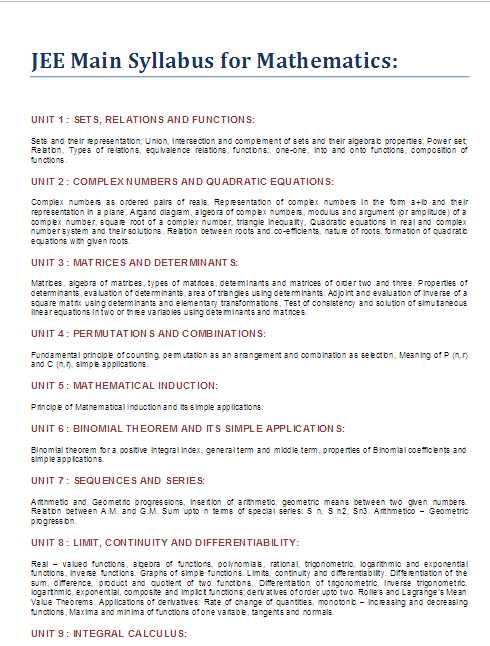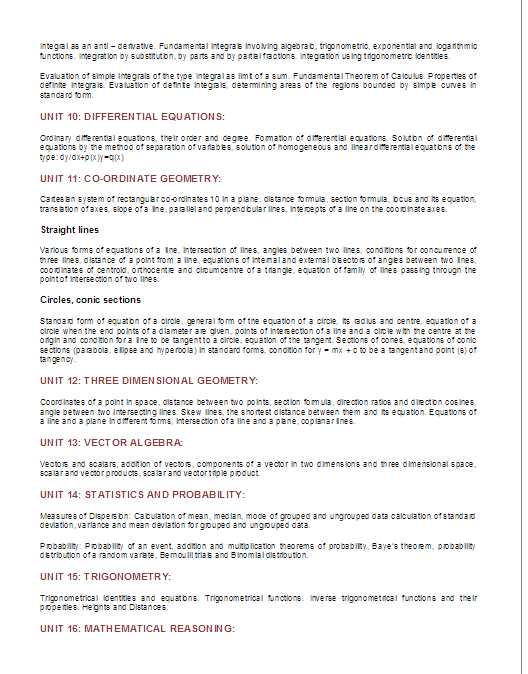|
#2
11th July 2017, 02:59 PM
| |||
| |||
| Re: VNIT Entrance Exam
The VNIT Nagpur was founded in 1960. This College is one of top Engineering Colleges in Maharashtra. It offers B.Tech Course with following disciplines: B Tech in Chemical Engineering B Tech in Computer Science Engineering B Tech in Metallurgical & Materials Engineering B Tech in Mining Engineering B Tech in Civil Engineering B Tech in Mechanical Engineering B Tech in Electrical & Electronics Engineering B Tech in Electronics & Communication Engineering The VNIT Nagpur takes admission in B.Tech Course through JEE Main Exam conducted by CBSE. I am providing syllabus of JEE Main Entrance Exam for your reference: JEE Main Exam Syllabus Physics, Chemistry Math PHYSICS: UNITS AND MEASUREMENT-S.I., fundamental and derived units. Dimensions and their applications. DESCRIPTION OF MOTION IN ONE DIMENSION-Motion in a straight line, uniform and non-uniform motion, their graphical representation. Uniformly accelerated motion, and its applications DESCRIPTION OF MOTION IN TWO AND THREE DIMENSIONS-Scalars and vectors, vector addition, a real number, zero vector and its properties. Resolution of vectors. Scalar and vector products, uniform circular motion and its applications projectile motion. LAWS OF MOTION-Force and inertia-NewtonS Laws of Motion. Conservation of linear momentum and its applications, rocket propulsion, friction-laws of friction WORK, ENERGY AND POWER-Concept of work, energy and power. Energy-kinetic and potential. Conservation of energy and its applications, Elastic collisions in one and two dimensions. Different forms of energy. ROTATIONAL MOTION AND MOMENT OF INERTIA-Centre of mass of a two-particle system. Centre of mass of a rigid body, general motion of a rigid body, nature of rotational motion, torque, angular momentum, its conservation and applications. Moment of Inertia, parallel and perpendicular axes theorem, expression of moment of inertia for ring, disc and sphere. GRAVITATION–Acceleration due to gravity, one and two-dimensional motion under gravity. Universal law of gravitation, variation in the acceleration due to gravity of the earth. Planetary motion, KeplerS laws, artificial satellite-geostationary satellite, gravitational potential energy near the surface of earth, gravitational potential and escape velocity. SOLIDS AND FLUIDS-Inter-atomic and Inter-molecular forces, states of matter (A) Solids : Elastic properties, HookS law, YoungS modulus, bulk modulus, modulus of rigidity. (B) Liquids : Cohesion and adhesion. Surface energy and surface tension. Flow of fluids, BernoulliS theorem and its applications. Viscosity, StokeS Law, terminal velocity. OSCILLATIONS-Periodic motion, simple harmonic motion and its equation of motion, energy in S.H.M., Oscillations of a spring and simple pendulum. WAVES–Wave motion, speed of a wave, longitudinal and transverse waves, superposition of waves, progressive and standing waves, free and forced Oscillations, resonance, vibration of strings and air-columns, beats, Doppler effect. HEAT AND THERMODYNAMICS–Thermal expansion of solids, liquids and gases and their specific heats, Relationship between Cp and Cv for gases, first law of thermodynamics, thermodynamic processes. Second law of thermodynamics, Carnot cycle, efficiency of heat engines. TRANSFERENCE OF HEAT-Modes of transference of heat. Thermal conductivity. Black body radiations, KirchoffS Law, WienS law, StefanS law of radiation and NewtonS law of cooling. ELECTROSTATICS-Electric charge-its unit and conservation, CoulombS law, dielectric constant, electric field, lines of force, field due to dipole and its behaviour in a uniform electric field, electric flux, GaussS theorem and its applications. Electric potential, potential due to a point charge. Conductors and insulators, distribution of charge on conductors. Capacitance, parallel plate capacitor, combination of capacitors, energy of capacitor. CURRENT ELECTRICITY-Electric current and its unit, sources of energy, cells-primary and secondary, grouping of cells resistance of different materials, temperature dependence, specific resistivity, OhmS law, KirchoffS law, series and parallel circuits. Wheatstone Bridge with their applications and potentiometer with their applications. THERMAL AND CHEMICAL EFFECTS OF CURRENTS–Heating effects of current, electric power, simple concept of thermo-electricity-See back effect and thermocouple, Chemical effect of current-FaradayS laws of electrolysis. MAGNETIC EFFECTS OF CURRENTS-OerstedS experiment, Bio-SavertS law, magnetic field due to straight wire, circular loop and solenoid, force on a moving charge in a uniform magnetic field (Lorentz force), forces and torques on currents in a magnetic field, force between two current carrying wires, moving coil galvanometer and conversion to ammeter and voltmeter. MAGNETOSTATICS-Bar magnet, magnetic field, lines of force, torque on a bar magnet in a magnetic field, earthS magnetic field, para, dia and ferro magnetism, magnetic induction, magnetic susceptibility. ELECTROMAGNETIC INDUCTION AND ALTERNATING CURRENTS-Induced e.m.f., FaradayS Law, LenzS Law, Self and Mutual Inductance, alternating currents, impedance and reactance, power In a.c. Circuits with L.C. And R Series Combination, resonant circuits. Transformer and A.C. generator. RAY OPTICS-Reflection and refraction of light at plane and curved surfaces, total internal reflection, optical fibre; deviation and dispersion of light by a prism; Lens formula, magnification and resolving power; microscope and telescope. WAVE OPTICS-Wave nature of light; Interference-YoungS double slit experiment. Diffraction-diffraction due to a single slit. Elementary idea of polarization. ELECTROMAGNETIC WAVES–Electromagnetic waves and their characteristics, Electromagnetic wave spectrum from gamma to radio waves-propagation of EM waves in atmosphere. ELECTRON AND PHOTONS– Charge on an electron, e/m for an electron, photoelectric effect and EinsteinS equation of photoelectric effect. ATOMS, MOLECULES AND NUCLEI–Alpha-particles scattering experiment, Atomic masses, size of the nucleus; radioactivity; Alpha, beta and gamma particles/ rays and their properties, radioactive decay law, half life and mean life of radio-active nuclei, binding energy, mass energy relationship, nuclear fission and nuclear fusion. SOLIDS AND SEMI-CONDUCTORS DEVICES-Energy bands in solids, conductors, insulators and semi-conductors, pn junction, diodes, diode as rectifier, transistor action, transistor as an amplifier. CHEMISTRY: Some Basic concepts-Measurement in chemistry, Laws of chemical combination. Atomic Mass, Molecular Mass, mole concept, Molar Mass, determination of Molecular formula. Chemical equation, stoichiometry of Chemical reactions. States of Matter-Gaseous state, measurable properties of gases, BoyleS Law, CharleS Law and absolute scale of temperature, AvogadroS hypothesis, ideal gas equation, DaltonS law of partial pressures. Kinetic molecular theory of gases. Atomic Structure-Constituents of the atom, lectronic structure of atoms-nature of light and electromagnetic waves, atomic spectra, bohrS model of hydrogen, shortcomings of the bohr model Dual nature of matter and radiation. Solutions-Types of solutions, Units of concentration, Vapour-pressure of solutions and RaoultS law. Colligative properties. Determination of molecular mass. Non-ideal solutions and abnormal molecular masses. Volumetric analysis-concentration unit. Chemical Energetics and Thermodynamics-Energy changes during a chemical reaction, Internal energy and Enthalpy, Internal energy and Enthalpy changes, Origin of Enthalpy change in a reaction, HessS Law of constant heat summation, numerical based on these concepts. Enthalpies of reactions(Enthalpy of neutralization. Chemical Equilibrium-Equilibrium involving physical changes. Equilibria involving chemical systems ,Effect of changing conditions of systems at equilibrium, Equilibria involving ions. Redox Reactions and Electrochemistry-Oxidation and reduction as an electron transfer concept. Redox reactions in aqueous solutions-electrochemical cells. EMF of a galvanic cell. Dependence of EMF on concentration and temperature Electrolysis, Oxidation number ,Balancing of oxidation-reduction equations. Electrolytic conduction. Molar conductivity. Rates of Chemical Reactions and Chemical Kinetics-Rate of reaction, Instantaneous rate of reaction and order of reaction. Factors affecting rates of reactions-factors affecting rate of collisions encountered between the reactant molecules, effect of temperature on the reaction rate, concept of activation energy, catalyst. Effect of light on rates of reactions Surface Chemistry-Surfaces : Adsorption-Physical and chemical adsorption, adsorption isotherms Colloids-Preparation and general properties, Emulsions, Micelles Catalysis : Homogeneous and heterogeneous, structure of catalyst, Enzymes, Zeolites Chemical Families-Periodic Properties Modern periodic law, Types of elements-Representative elements Transition elements –d-block elements, inner transition elements-f-block elements Chemical Bonding and Molecular Structure-Chemical bonds and Lewis structure, shapes of molecules. Quantum theory of the covalent bond, hydrogen and some other simple molecules, carbon compounds, hybridization, Boron and Beryllium compounds.. Chemistry of Non-metals-I Hydrogen, Hydrides-molecular, soline and interstitial Oxygen simple oxides; ozone Water and hydrogen peroxide, structure of water molecule and its aggregates, physical and chemical properties of water, hard and soft water, water softening, hydrogen peroxide Chemistry of Non-Metals-II Boron-occurrence, isolation, physical and chemical properties, borax and boric acid, uses of boron and its compounds. Carbon, inorganic compounds of carbon-oxides, halides, carbides, elemental carbon. Silicon-occurrence, preparation and properties, oxides and oxyacidS of phosphorus, chemical fertilizers Chemistry of lighter Metals-Sodium and Potassium-occurrence and extraction, properties and uses. Important compounds-NaCl, Na2CO3, NaHCO3, NaOH, KCI, KOH. Magnesium and calcium-occurrence and extraction, properties and uses. Heavy Metals-Iron-Occurrence and extraction, compounds of iron, oxides, halides, sulphides, sulphate, alloy and steel. Copper and silver-occurrence and extraction, properties and uses, compounds-sulphides, halides and sulphates Chemistry of Representative Elements-Periodic properties-Trends in groups and periods (a) Oxides-nature (b) Halides-melting points (c) Carbonates and sulphates-solubility. The chemistry of s and p block elements, electronic configuration, general characteristic properties and oxidation states of the following :-Group 1 elements-Alkali metals and Group 2 elements Transition Metals including Lanthanides-Electronic configuration: General characteristic properties, oxidation states of transition metals. First row transition metals and general properties of their compounds-oxides, halides and sulphides. General properties of second and third row transition elements Coordination Chemistry and Organo Metallic-Coordination compounds, Nomenclature : Isomerism in coordination compounds; Bonding in coordination compounds, WernerS coordination theory. Applications of coordination compounds. Nuclear Chemistry-Nature of radiations from radioactive substances. Nuclear reactions; Radioactive disintegration series; Artificial transmutation of elements; Nuclear fission and Nuclear fusion: Isotopes and their applications: Radio carbon-dating. Purification and Characterization of Organic Compounds-Purification (crystallization, sublimation, distillation, differential extraction, chromatography).Qualitative analysis, detection of nitrogen, sulphur, phosphorus and halogens.Quantitative analysis-estimation of carbon, hydrogen, nitrogen, halogens, sulphur, phosphorus Some Basic Principles-Classification of Organic Compounds. Tetravalency of Carbon. Homologous series. Functional groups– –C = C –,-C C –, and groups containing halogen, oxygen, nitrogen and sulphur. General introduction to naming organic compounds-Common names and IUPAC nomenclature of aliphatic, aromatic and Cyclic Compounds. Hydrocarbons-Classification. Sources of hydrocarbons: Alkanes-General methods of preparation (from unstated hydrocarbons, alkyl halides, aldehydes, ketones and carboxylic acids). Physical properties and reactions (Substitution, oxidation and miscellaneous). Conformations of alkanes Organic Compounds Containing Halogen-Methods of preparation, physical properties and reactions. Preparation, properties and uses of Chloroform and Iodoform, Organic compounds containing Oxygen-General methods of preparation, correlation of physical properties with their structures, chemical properties and uses of Alcohols, polyhydric alcohols, Ethers, aldehydes, ketones, carboxylic acids and their derivatives, Phenol. Organic Compounds Containing-Nitrogen Nomenclature and classification of amines, cyanides, isocyanides, nitro compounds and their methods of preparation; correlation of their physical properties with structure, chemical reactions and uses-Basicity of amines Synthetic and Natural Polymers-Classification of Polymers, natural and synthetic polymers and important uses of the following : Teflon, PVC, Polystyrene, Nylon-66, terylene, Bakelite Bio Molecules and Biological Processes-The Cell and Energy Cycle Carbohydrates : MonosaccharideS, Disaccharides, Polysaccharides Amino acids and Peptides-Structure and classification. Proteins and Enzymes-Structure of Proteins, Role of enzymes. Nucleic Acids-DNA and RNA Biological functions of Nucleic acids-Protein synthesis and replication Lipids-Structure, membranes and their functions. Chemistry in Action-Dyes, Chemicals in medicine, Rocket propellants, Mechanism of reaction, Photochemical reactions, photography. Zinc and Mercury –occurrence and extraction, properties and uses, compounds -oxides, halides; sulphides and sulphates. Tin and Lead-occurrence and extraction, properties and uses, compounds oxides, sulphides, halides, elimination and rearrangement reactions. Illustrations with examples. Environmental Chemistry-Environmental pollutants; soil, water and air pollution; major atmospheric pollutants; acid rain, Ozone and its reactions causing ozone layer depletion, effects of the depletion of ozone layer, industrial air pollution. JEE MAIN Mathematics Syllabus   Last edited by Rajkumar Agarwal; 11th July 2017 at 03:29 PM. |